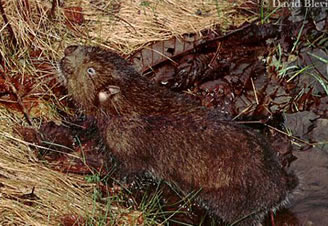

NATURE NOTES

Mountain Beaver (Aplodontia rufa) burrows among the hummocks, photo by Hugh Griffith
Not just a hole in the ground...
by
The skull of a Mountain Beaver was among the oddball skeletal samples our professor placed on lab exams back in Mammalogy class at the Royal Ontario Museum. None of us had ever seen a Mountain Beaver, because they don’t live in Ontario. The textbook picture was grainy, portraying what resembled a dark, unkempt and deranged guinea pig. This was a creature of the western wilds, almost never seen, with an almost Sasquatch-like mystique. Added to that, the Mountain Beaver was described as "the most primitive living rodent." If that isn’t an insult, I don’t know what is.
Mountain Beaver is a misnomer. It is not a high elevation version of our national symbol. It is a short-tailed forest animal that lives from sea level to the tree line, preferring dense understorey and soggy ground that allows tunnelling. Its diet consists of a wide range of vegetation, including coarse plants other herbivores will avoid. It sometimes creates "haystacks" of drying food outside its burrows.

Mountain Beaver, photo by David Blevins
Recently I experienced the thrill of discovery while with a group of biologists on a mountainside near Chilliwack. One who knew the area well pointed out a hole in the ground the diameter of a hockey puck. "Mountain Beaver burrow," he said. My reaction, "Wow! Mountain Beaver!" betrayed my eastern roots. A closer look revealed a number of inconspicuous holes within a cluster of small, mossy hummocks.
The Mountain Beaver is one of several poorly-known, unglamorous, ground-dwelling species in the Lower Fraser Valley threatened with extirpation as human interests expand. It is particularly vulnerable to forestry, which destroys both its forest habitat and the soil in which it burrows. Although officially a species of concern under the federal Species At Risk Act and protected from deliberate killing by the BC Wildlife Act, the protection tends not to apply under certain highly disruptive forestry practices. A hundred metres above the burrows we came across was a devastating clear-cut in which the soil had been stripped bare. Almost certainly there had been Mountain Beaver up there who disappeared without anyone noticing, or trying to notice
At the Royal Ontario Museum, undergraduate students will continue to puzzle over that same small skull, as the number of wild owners of similar skulls grows smaller and smaller still.
Hugh Griffith is a BC zoologist and science writer.
Please cite these pages as:
Author, date, page title. In: Klinkenberg, Brian. (Editor) 2021. E-Fauna BC: Electronic Atlas of the Fauna of British Columbia [www.efauna.bc.ca]. Lab for Advanced Spatial Analysis, Department of Geography, University of British Columbia, Vancouver. [Date Accessed]
© Copyright 2021 E-Fauna BC.